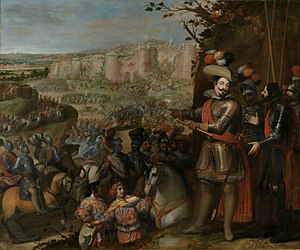Siege of Rheinfelden (1633)
| Siege of Rheinfelden (1633) | |||||||
|---|---|---|---|---|---|---|---|
| Part of the Thirty Years' War | |||||||
 The Capture of Rheinfelden by Vincenzo Carducci. | |||||||
| |||||||
| Belligerents | |||||||
|
|
| ||||||
| Commanders and leaders | |||||||
| Unknown |
| ||||||
| Strength | |||||||
| Unknown | 20,000 troops[1][2] | ||||||
The Siege of Rheinfelden of 1633 or the Spanish recapture of Rheinfelden (Spanish: La Expugnación de Rheinfelden) took place in late October 1633, during the Thirty Years' War.[1][2] The Spanish army (20,000 troops)[1] of the Governor of the Duchy of Milan, Don Gómez Suárez de Figueroa, Duke of Feria, (Spanish Army of Alsace), after relieving and taking Konstanz, Breisach and Bregenz, captured by storm the Swiss city of Rheinfelden, as part of the plan designed by the favourite and chief minister of Philip IV of Spain, Don Gaspar de Guzmán, Count-Duke of Olivares, to release the Rhine route of the harassment by Swedish, French and Protestant-German troops (Heilbronn League), defend the Franche-Comté, safeguard the Tyrol, support the troops of the Holy Roman Empire, and open a strategic corridor for the Spanish troops from the Spanish Lombardy to the Spanish Netherlands.[1][2]
See also
- Heilbronn League
- Catholic League
- Duchy of Milan
- Franche-Comté
- List of Governors of the Duchy of Milan
Notes
External links
- Biografía de Don Gómez Suárez de Figueroa, III Duque de Feria Template:Sp icon
- The Thirty Years War – The Catholic Encyclopedia
References
- Black, Jeremy. European Warfare 1494–1660. Routledge Publishing (2002) ISBN 978-0-415-27531-6
- Parker, Geoffrey (1984). The Thirty Years' War. London: Routledge and Kegan Paul. ISBN 0-415-15458-8
